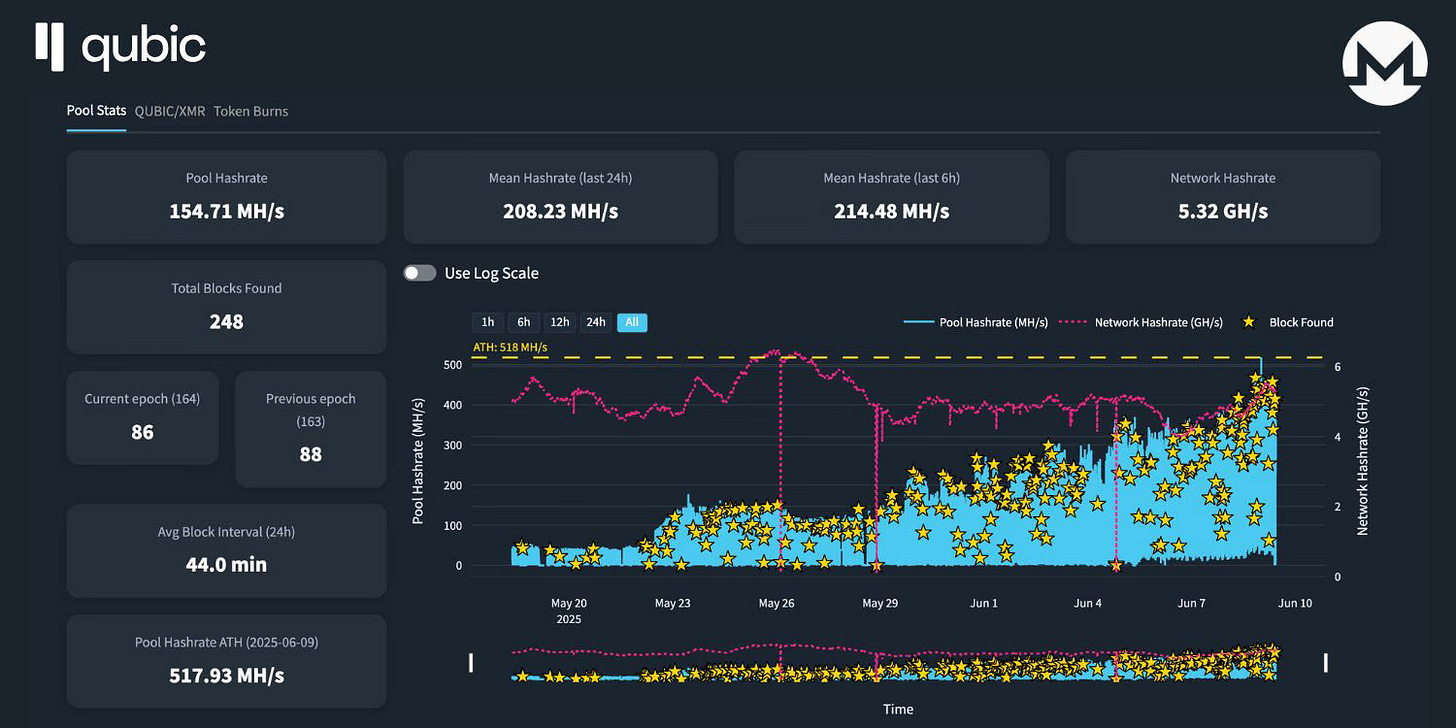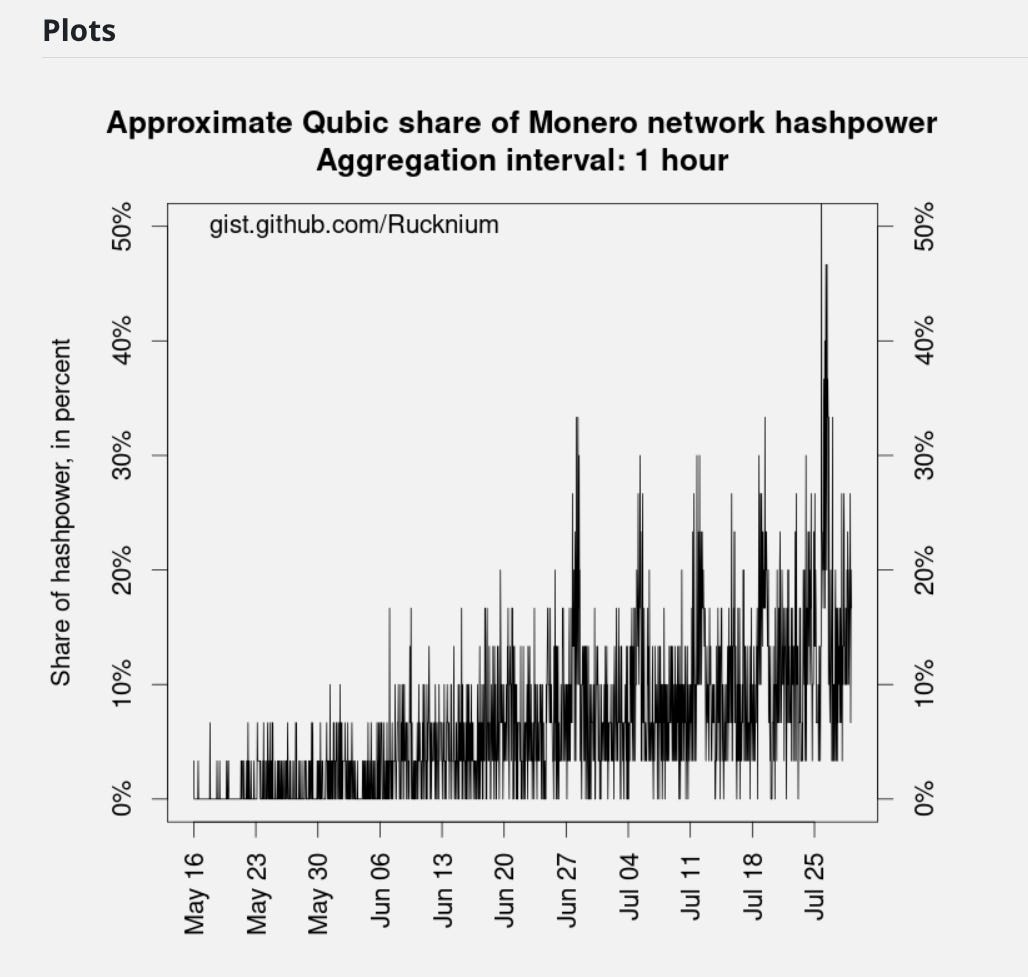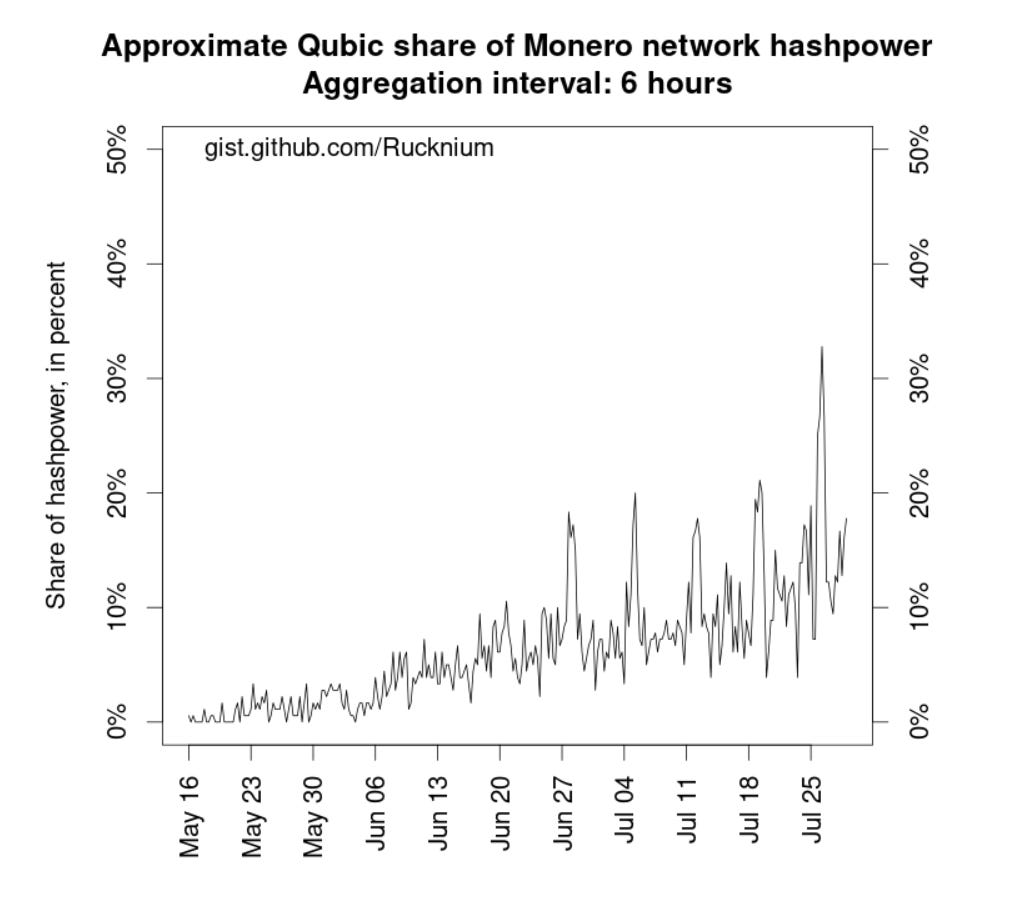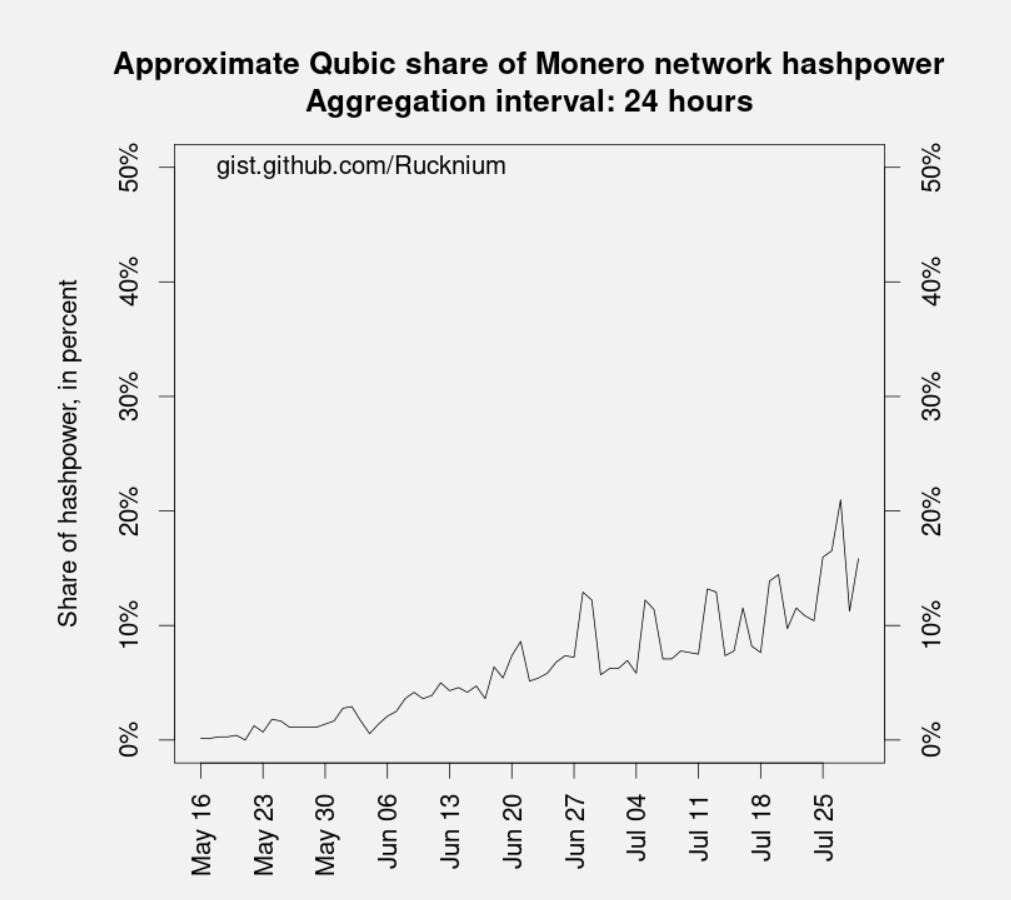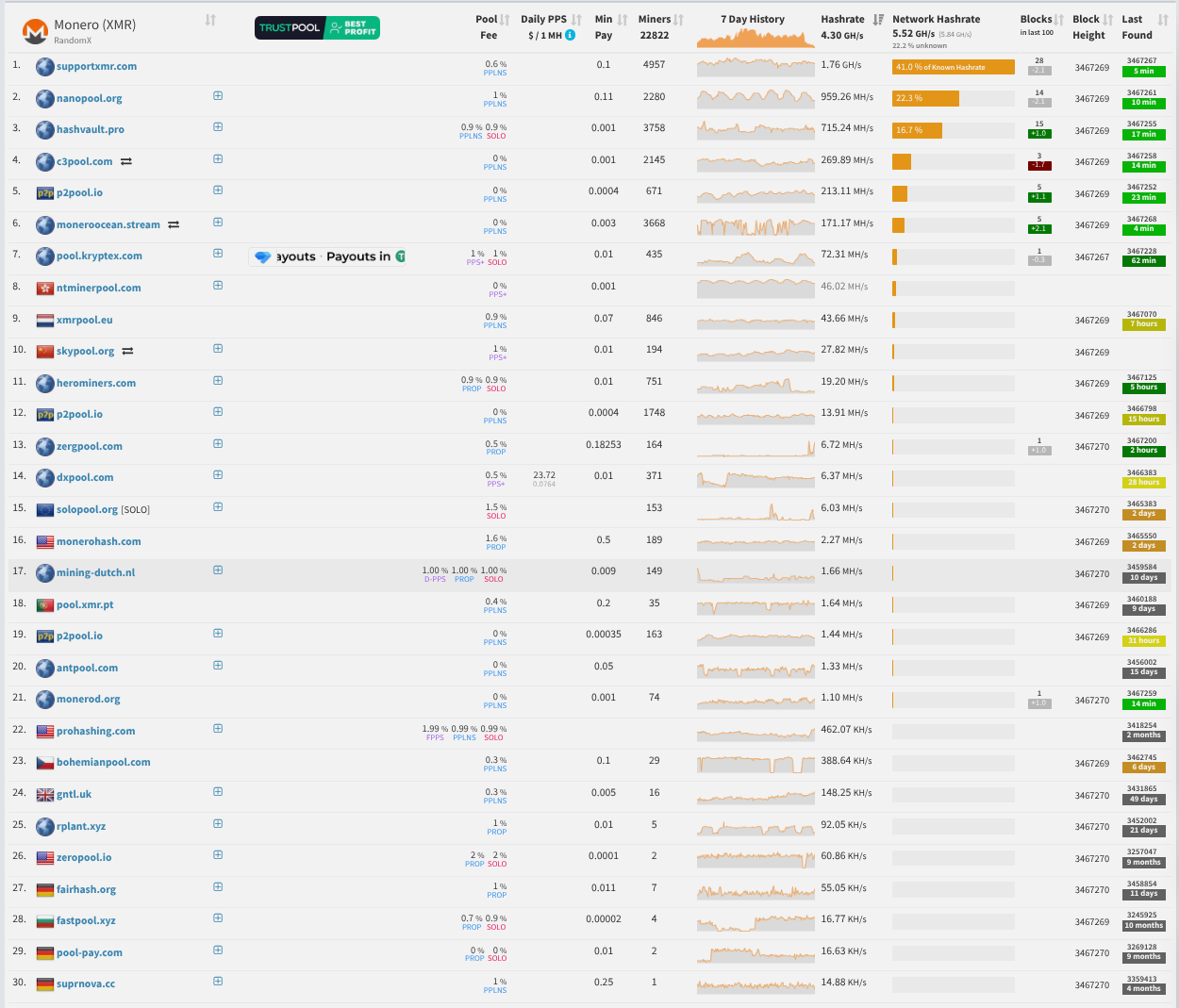For the first time ever, a coin has openly announced its intention to 51% attack none other than Monero, the world’s most popular privacy coin. We’re about to see a centralized tightly controlled cryptocurrency that normally trains AI fight against another that embraces decentralization and privacy to its very core. We’ll discuss why this is so important, and whether it’s even possible for the attack to succeed.
What’s Monero?
It’s the private by default cryptocurrency that is loved by many for its extreme privacy features, friendly community, and being easy to use and mine. Blockchain surveillance firms have failed to trace Monero, and we’ve documented this at length on #TBOT in our article “IRS Attempts To Trace Monero”.
The Planned Takeover
The attacking project “Qubic” is now devoting all of its computing power to attempt to takeover Monero, by ordering its miners to mine Monero, effectively acting as a botnet.
As you know, if miners reach 51% of a cryptocurrency’s hashrate (mining power over time) they can take over the coin. Qubic’s founder has openly stated their goal is to take over Monero’s block rewards, and force out other miners on the Monero network by excluding them from mining rewards.
Qubic’s community are quick to point out screenshots of high hashrates which imply that Qubic is mining upwards of 30% of Monero’s total hashrate. Monero community members have responded with a statistical analysis of Qubic’s hashrate that provides context by estimating their hashrate over time.
Both sides likely have cards that haven’t been played yet that could decide the direction of the attack.
Still, the open intention to takeover another coin shouldn’t be ignored. If you care about privacy, consider learning how to mine Monero. Our solution is at the end of this article and covered in #TBOT Show 8.
The Centralized AI Botnet - Qubic
The coin causing waves is called Qubic. It was developed by Sergey Ivanchelgo, known for his work on other projects like NXT and IOTA.
Qubic is a Layer 1 cryptocurrency distinguished by its “Useful Proof of Work (UPoW)”.
In a normal cryptocurrency, all miners are solving mathematical challenges with their computers to decide the next block and gain a reward. Instead of solving math challenges, the Qubic network does “useful” things like training artificial neural networks and machine learning models.
Qubic is also centralized. An arbitrator decides the challlenges, and a consensus layer of 676 powerful servers, called computors distribute rewards based on performance.
The arbitrator is 'anonymous’ and its rulings are final—whatever it decides, the network must do, until it has a new tasks for the network to solve.
“The entity controlling the current Arbitrator remains unknown, though rumours suggest it is operated by the development team.”
This is similar to a botnet, where a single entity controls a network of computers performing the same task. While criminals use botnets to overwhelm websites, a centralized cryptocurrency like Qubic can use it to mine cryptocurrency and move towards a 51% attack.
It’s unclear exactly what artificial neural network challenges miners tackle daily, but documentation indicates any problem solvable by an ANN, such as image recognition, is possible.
Unfortunately, it doesn’t look like training AI has been paying so well, hence the shift to mining Monero and other currencies.
The Shift to Mining Monero
In June, Qubic announced the ability to merge mine Monero (XMR) and Tari (XTM), claiming to have reached around 10% of Monero’s total hashrate.
Keep in mind that the arbitrator has total control over what the network is doing. The trend lines in the graph don’t indicate organic growth throughout the network, but a programmatic increase in the proportion of resources used to mine Monero.
Once all of the Qubic network is fully utilized mining Monero, there’s no way to increase their hashrate besides growing the network.
The Qubic network is also merge mining (mining multiple coins at the same time). However, miners don’t get paid in the Monero and Tari they mine.
The network immediately sells them for Qubic and pays the miners in Qubic.
In Qubic, the arbitrator decides for you. All hail the arbitrator.
What’s the plan?
Sergey, founder of Qubic posted a matter-of-fact Tweet outlining his plan. He’s very confident that Qubic will reach 51%.
A 51% attack needs to be maintained over time to profit off the network. As soon as the Monero community increases their mining resources, and pushes Qubic to a sub-50 percentage, the attack will stop.
What can Qubic do then? Sergey has prepared for this case by making it very hard to determine Qubic’s total hashrate. They’ll do this in a few ways:
disassocating the wallets they use to mine from Qubic
taking down any public statistics
flooding the Qubic network with fake traffic to make it hard to monitor
Talk about dedication.
As for achieving the attack itself?
Qubic will ban Monero miners from adding to the blockchain, allowing only Qubic miners to mine blocks and receive rewards.
Monero has dynamic block sizes and dynamic minimum fees to encourage a consistent growth of the blockchain even if there are dramatic changes in hashrates and transaction volumes.
At the time of writing, there are about 750~ blocks mined per day on Monero. At the current price of $305.79 the total daily mining rewards amount to $140,000 per day.
Achieving 51% would allow Qubic to claim all mining rewards—$140,000 per day—while contributing only half the work.
It’s high stakes economic warfare.
If the attack was achieved, Monero transactions would become uncertain in the short term.
Qubic miners would reject blocks from outside the community, leading to a struggle in consensus. This could lead to many orphaned blocks, which could result in bad actors double spending their Monero.
Receivers of Monero would need to increase their number of confirmations before accepting a transaction, and transactions would take a very long time to confirm. Those who accept transactions at lower confirmations would risk losses.
Ironically, a 51% takeover would also erode trust in the coin and drop the price—which means that Qubic’s mining income would drop significantly.
What does Monero have to say about it?
The Monero community has remained largely unconcerned. There has been no official response, but Rucknium, a statistican from the Monero Research Lab, did publish an analysis of Qubic’s hashpower on their Github.
We previously featured Rucknium’s insights in our article about Monero’s resistance to Chainanalysis.
The analysis used the single Monero wallet that Qubic was using to mine. It identified blocks mined by this wallet and calculated Qubic’s approximate hashrate by dividing it by the total blocks mined in the same time period.
For example, if Qubic mined one block in a one-hour interval, then their approximate share of hashpower during that one hour is 1/30 = 3.3% because approximately one Monero block is mined every 2 minutes.
The analysis found that the hashrate and blocks earned by Qubic was erratic, spiking up and down on regular intervals.
In one hour intervals, spikes reaching 50% were seen.
With six hour intervals, the estimated hashrate could not surpass 40%.
And with one day intervals, it hardly passed 20%.
Based on past performance, a sustained 51% attack seems unlikely.
However, Qubic may have cards left to play.
Because Qubic mining is programatic, completely decided by the arbitrator, the past few weeks may have been tests to preview the mining performance. It’s possible that not all of the network was mining Monero.
Rucknium also notes there are websites where you can rent cryptocurrency miners that could add up to 17% of Monero’s current hashrate, usable for attack on Qubic’s side or defense on Monero’s side.
This is speculation but I would think a community as large and well organized as Monero would have contingency plans in place for something exactly like this.
There might be “sleeper nodes” activated when a realistic threat emerges.
How will I be able to tell?
From a user perspective, we won’t really be able to detect trouble before the 51% attack.
Watching Mining Charts would be easy, but Qubic has stated they will hide their mining addresses—making it difficult for anyone to measure their hashrate. The likely solution would be dozens of different mining addresses, all linked to Qubic but kept incognito, you won’t be able to tell just by looking at the name.
For historical record, here’s the chart as of July 30th, 2025.
With the current number of 42 mining pools, we’ll be able to see if the pool count grows signifciantly.
It’s also possible that Qubic runs a solo mining operation, not tied to any pool. We would see a large increase in blocks with unknown miners.
The situation remains unclear. Both sides hold cards that we won’t see until the final showdown.
All we might see are high numbers of orphaned blocks and double spends, and a collection of unknown miners on the Monero network.
You might say covering this story doesn’t bring Monero benefit, it could potentially draw people to Qubic—but I think it’s an important new dynamic that is evolving in the world of crypto.
Either Qubic will try their hardest and fail.
Or Monero may be forced to take a step back and reassess the strength of their network, and any other proof of work coins should follow suit.
Regardless of whether Qubic is being malicious, ultimately the whole cryptocurrency movement learns a lesson and grows.
And for those thinking of investing in Qubic, just note that they have 150 Trillion coins already created, with a maximum of 200 trillion.
Solutions
I am wholly behind Monero, and although no one is taking it very seriously, I will be mining Monero on my personal computers. And you can too with Gupax.
Gupax is a GUI program that makes it easy to Mine monero on any device. It works on Windows, macOS, and Linux.
It features p2pool for trustless pool mining and immediate payouts without fees.
I learned about Gupax through this SethForPrivacy article.
How to start mining
Install Gupax from the downloads page, make sure to download the Bundle.
Extract the bundle and run the Gupax executable.
In the main menu, switch over to P2Pool.
Set your Monero mining address where you receive payouts.
Pick a remote Monero node or configure your own.
Switch over to the Gupax tab.
You will need to enter your sudo password as Gupax needs it for lower level optimizations. It doesn't save the password, it will ask everytime you need to start Gupax again.
If concerned about this, please verify the checksum of the download. The checksums are listed at the bottom of the Downloads page for each respective file.
From here set your Monero mining address where you receive payouts.
Also, you can pick a remote Monero node or configure your own.
It’s recommend to use your own Monero node or one you trust. There are privacy implications as the node you use can pick up your IP address and basic information about your transactions.
But if you’re just getting started or want to try it out, you can pick a remote node. Just know it’s not recommended for long term use or for users that want to maximize their privacy.
After you pick a node or configure your own, you can press the play button at the bottom and that will start p2pool.
Wait a few minutes until p2pool turns green, and that’s it—you’re mining Monero. I’ts really easy and you’re contributing to the Monero network. Every computer that’s mining makes it that more resistant to outside attackers.
Conclusion
The ultimate battle of centralization vs decentralization rages on. You have two projects which embody each idea. A centralized AI coin with zombie miners who do the bidding of the arbitrator. And Monero, a rag tag group of strangers on the internet who are ensuring we have private money.
You can make a difference: it may just take a single laptop or gaming computer to alter the course of events in one side’s favor.
Will you answer the call?
Finally, a laptop that respects your privacy and your freedom of choice.
✅ Modern reliable hardware.
✅ A cutting-edge Linux OS that's actually easy to use.
✅ Access to more software than ever before.
❌ And best of all, no big tech tracking!



